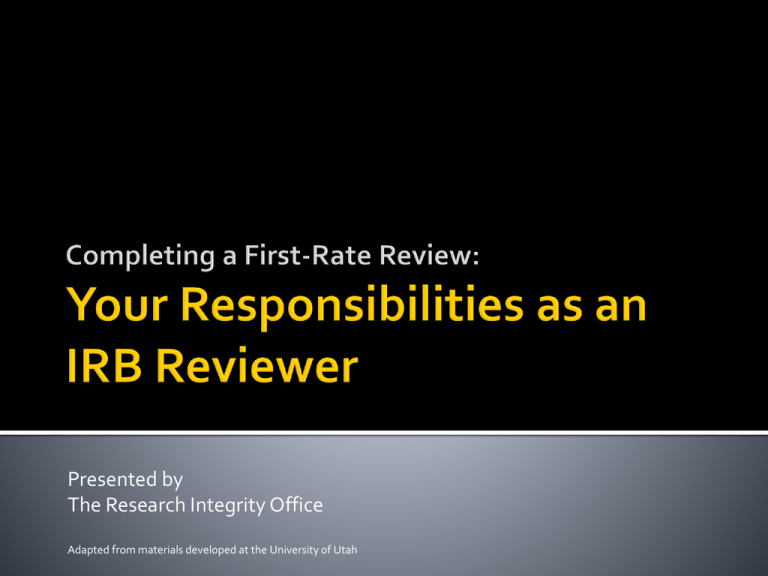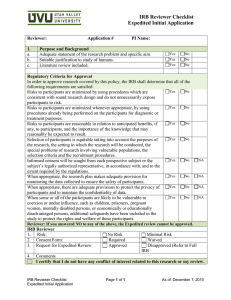
Presented by
The Research Integrity Office
Adapted from materials developed at the University of Utah
Knowledgeable
▪ The regulations, research, the IRB process
Thorough
Thoughtful
Collaborative
▪ With investigators, the IRB staff, colleagues on the panel
Reasonable
To protect the rights and welfare of
research participants
The IRB is charged with the responsibility of reviewing
and overseeing human subject research.
The IRB review process is designed to protect the
rights and welfare of human subjects by ensuring:
▪
▪
▪
▪
Equitable selection of participants
Assuring adequate informed consent
Assessing and minimizing risks
Maintaining privacy and confidentiality
Some basics about the regulations and where
they come from…
Tuskegee Syphilis Study came to light in the
early 1970’s
National Commission created by Congress to
develop principles and policy for research
oversight (the Belmont Report)
Peer review (i.e. the IRB) is established as an
essential component of research ethics
▪ Informed consent
▪ Investigator integrity
OHRP is an office within the
Dept. of Health & Human Services (DHHS) that
deals with the ethical oversight of research.
Tip for interpreting the regs: “Know the lingo”
▪ “Must” = Required
▪ “Should” = Recommended or Suggested
http://www.hhs.gov/ohrp
45 CFR 46 consists of Subparts A-D
▪ Subpart A: “The Common Rule”
▪ Subpart B: Additional protections related to research
involving fetuses, neonates, and pregnant women
▪ Subpart C: Additional protections related to research
involving prisoners
▪ Subpart D: Additional protections related to research
involving children
Risk: Is the risk to the participant minimized?
Have the investigators done everything they can to ensure the
participants are only exposed to risk absolutely necessary to
conduct the research?
Validity: Will the study yield results that matter?
More on this in a moment…
Consent: Is the consent document clear & easy
to understand?
Is the consent document written appropriately for the population
being studied?
Minimal Risk: The probability and magnitude
of harm and discomfort anticipated in
research are not greater than those ordinarily
encountered in daily life or during the
performance of routine physical or
psychological tests
Greater than Minimal Risk: Not minimal, or
“less than” minimal risk.
How do we ensure the risks to participants
are minimized?
1. Use procedures consistent with sound research design
and which do not unnecessarily expose subjects to risk
2. Whenever appropriate, use procedures already being
performed on the subjects for diagnostic or treatment
purposes
What is the risk/benefit ratio?
The comparison of the risk of a situation to its
related benefits.
For research that involves more than minimal
risk of harm to the subjects, the investigator
must assure that the amount of benefit clearly
outweighs the amount of risk.
What do you think?
45 CFR 46.111:
▪ In order to approve research, risks to subjects are minimized by
using procedures which are consistent with sound research design
Ethical Science = Good Science
It is unethical to pose any risk to subjects if no valid
results will be obtained from the project.
Declaration of Helsinki (2000):
▪ Human research must conform to accepted scientific principles and
be based on thorough knowledge of the literature
▪ Human research should only be done if the importance of the
objective outweighs the risks and burdens to participants
If a change in the study design will meaningfully
reduce the risk to participants without
compromising the study results, the Board should
not approve the study until the change is made.
Note: If the study is less than minimal risk and the design is flawed (but not
fatally), there is no real ethical justification for the IRB to require mandatory
revisions to the study design
▪ For example, undergraduate student research projects
Artwork © 2001 by Don Mayne. Permission granted for non-commercial reproduction with attribution; all other rights reserved. Contact: dontoon@aol.com.
Is there a thoughtful and thorough plan in place
to document informed consent?
Is the process of obtaining consent adequately
described?
Have any waivers been requested? Are they
approvable/appropriate?
Are all of the required elements of informed
consent present?
Your Reviewer Checklist, the IRB consent template, and the
IRB staff will help you with this…
Risks are minimized
Risk/Benefit Ratio is reasonable
▪ Risk/Benefit Ratio: The comparison of the risk to its related
benefits.
▪ Benefit: Includes direct benefit to the participant, and anticipated
benefit to society.
Equitable selection of participants
Informed consent is obtained as needed
Consent is documented as required
Data is monitored to ensure safety of participants
Privacy and confidentiality is protected
▪ Privacy: People. Are embarrassing or sensitive activities conducted in a
private room? Are research staff trained not to use participant names in
public hallways? Etc.
▪ Confidentiality: Data about people. Are the laptops being used for data
entry encrypted? Is the office where the charts are stored locked at all
times?
Vulnerable populations are protected
Establish a routine for reviewing the
application
For example:
1.
Skim the Consent Document(s).
Don’t worry too much about taking notes or making revisions, just get an idea of
what’s going on in the study…
2.
Read the Protocol Application
3.
Read the supporting documents thoroughly. Take notes as needed.
4.
Re-read the Consent Document(s) carefully. Make sure the
document makes sense now that you are familiar with the rest of the
application. Are participants being informed of everything they need
to know?
5.
Complete the appropriate checklists.
Will a change in the application be likely to
improve the welfare of research subjects to a
meaningful degree?
If not, approve the study without the change.
If so, require the change be made prior to approval.
Are my revisions clear?
The IRB staff will be communicating your requests to the study
team… Make sure it is clear what you are asking for.
Don’t sweat the small stuff
Don’t worry too much about correcting typos, formatting, etc.,
unless the correction will significantly improve the document or
change the meaning of the document.
Revisions should be substantive and meaningful.
Make sure you submit
your checklist
▪ This will be the signal to
your coordinator that you
are done with your review
▪ The coordinator will use
your checklist as a guide to
draft the minutes
Primary Reviewer:
Limit the summary of the
study to 1-2 minutes
Be precise about the changes
required to the study
End your presentation with a
recommendation for the vote
(pending the secondary
reviewer’s comments)
Secondary Reviewer:
Focus on any areas of
disagreement with the
primary reviewer
Discuss the Consent
Document and consent
process
End your presentation with a
recommendation for the vote
Summarize the study (1-3 sentences)
▪ Progress of the study
▪ Enrollment status
Open/closed, suspended
Over/under accrued
▪ Number of participants accrued
Have there been any adverse events (AE) or
unanticipated problems (UP) since the last
continuing review? Has any new information
emerged that changes the risk to participants?
▪ DSMB findings, if applicable
▪ Withdrawals, complaints, multi-center reports, etc.
Provide a summary of any significant Amendments
since last review. Have any of the changes required
revisions to the Consent Document?
Have there been any significant changes to the
Consent Document since the last continuing review?
Is the document still accurate and appropriate?
Summarize the study (1-3 sentences).
Describe the changes that are being requested.
State whether or not the changes will affect the
risk/benefit ratio of the overall study.
State whether or not the changes are
acceptable/approvable.
Ask questions before the meeting
Contact the study team
Collegial interactions with the research community facilitate the review
process and promote respect for the IRB!
Contact the IRB staff
Contact your fellow board members
Come with your revisions ready to go
Keep your meeting coordinator informed
If you contact the study team, make sure your
coordinator knows what’s going on… they are the final
gate keepers that ensure your revisions have been
included in the final version of the application!
If I disapprove a study, what happens?
The study is returned to the study team for
additional revision.
The study comes back to the same panel and
reviewer the following month for re-review.
Coordinator assigns an
expedited action to a
designated reviewer
Reviewer receives a
notice via email that
they have been
assigned to review the
application
Expedited reviewer
completes appropriate
checklist(s) and sends
them to the coordinator
Coordinator completes
processing, sends
determination letter to
PI
Expedited reviewer or
coordinator reviews
revisions, depending on
nature of changes
If needed, revisions are
requested from the
study team by the
Coordinator
You will likely be designated as an Expedited Reviewer in about 2 months…
Some topics get more discussion time during the meeting than others… It’s helpful
to have members in the room that really know their stuff about these issues. The
IRB staff can help.
Vulnerable populations
Child Categories
Participants with diminished
cognitive capacity/LARs
Waivers
Waivers of parental
permission
Randomization to
placebo-only arm
Placebo guidelines
DSMPs
Research-Related
Injury/Sponsor liability
IND/IDE
Tissue/Specimen Banking
Approved
• The research meets the DHHS criteria for IRB approval.
Approve with
Conditions
• The DHHS requirements for IRB approval are or will be met with minor
revisions or directed changes. The IRB specifies who may review/approve
the revisions.
Deferred
• Substantive revisions are necessary to meet the requirements for
approval and requires subsequent review by the convened IRB unless the
IRB determines that the study is eligible for expedited review.
Abstain
• Appropriate when the member has insufficient information to make an
informed decision (e.g. entered the room late, etc.).
NOTE: The IRB has the authority to "not approve" research that does not meet the
criteria for IRB approval and requires significant changes to protect the participants.
Questions?
Ross Hall, Room 218
Mail Stop 0331
University of Nevada, Reno
Reno, NV 89557-0331
(775) 327-2368
Valerie Smith, Coordinator
775-327-2370
valeries@unr.edu
Nancy Moody, Director
775-327-2367
nmoody@unr.edu
Jan Anderson, Office Manager
775-784-3506
gwenns@unr.edu
Ray Avansino, IRB Specialist
775-327-2372
ravansino@unr.edu
Michelle Groy,
Quality Improvement Officer
775-327-2373 ~ mgj@unr.edu


